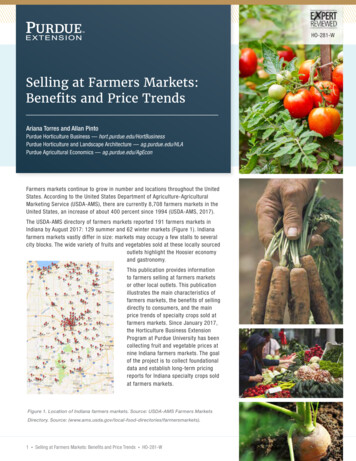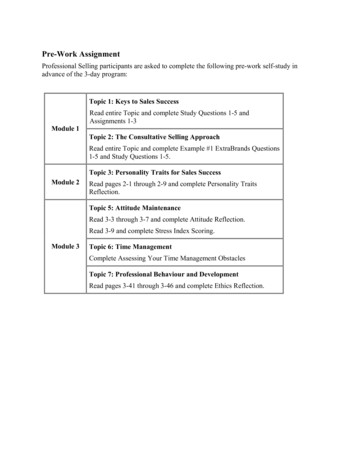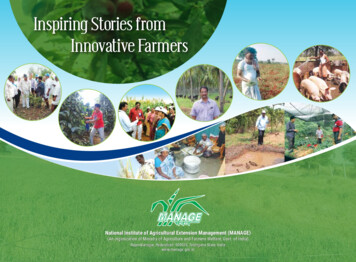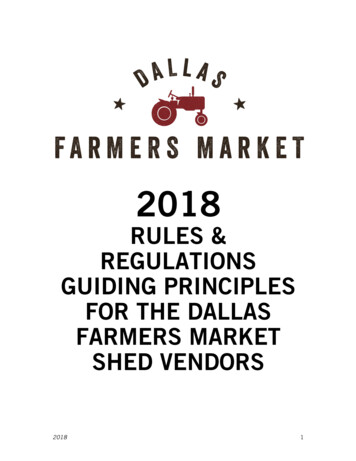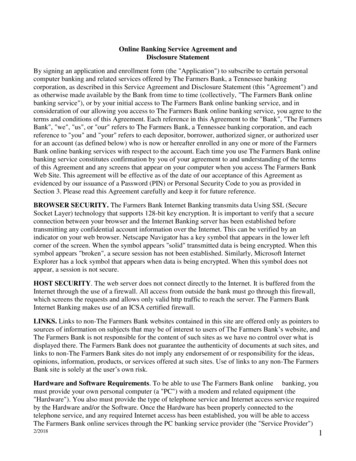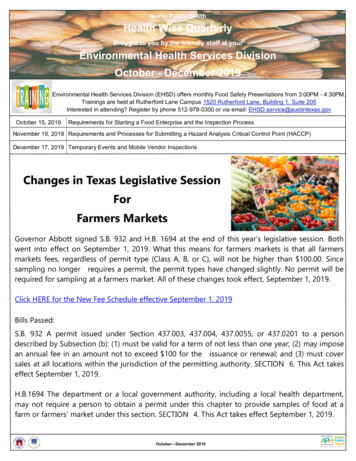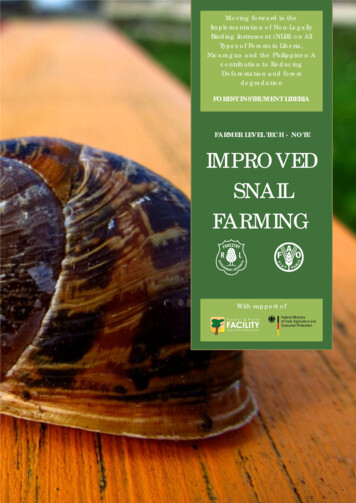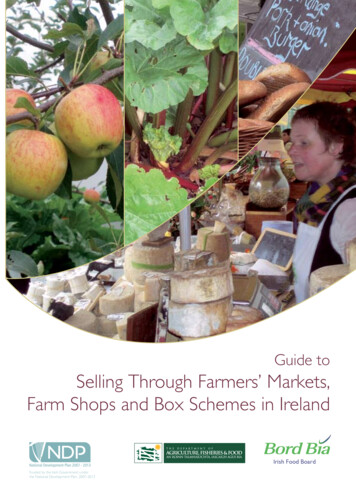
Transcription
Guide toSelling Through Farmers’ Markets,Farm Shops and Box Schemes in IrelandIrish Food BoardFunded by the Irish Government underthe National Development Plan, 2007-2013
Foreword 3Section 1: Introduction 5Section 2: Why alternative routes to market? 6Section 3: Local food 7Section 4: Profile of farmers’ markets in Ireland 8Section 5: Getting started. 13Section 6: Your first day in the farmers’ market 25Section 7: Ongoing considerations 32Section 8: Farm shops 37Section 9: Box schemes 44Section 10: Conclusion 51Appendix 1: Sample pricing models 52Appendix 2: Useful contacts/acknowledgements 56Guide to Selling Through Farmers’ Markets, Farm Shops and Box Schemes in IrelandContents
Guide to Selling Through Farmers’ Markets, Farm Shops and Box Schemes in Ireland
ForewordFarmers’ markets afford local producers the unique opportunity ofselling directly to the consumer. A further bonus to such a transactionis the market research opportunity which meeting the public affords. Inreturn, consumers are looking for direct access to farmers and producers.Consumer interest in reducing carbon footprints and food miles alsoexplains why farmers’ markets and farm shops are growing in popularity.Farmers’ markets and other forms of direct selling are here for the long haulbut, as with any commercial enterprise, their individual success rests on howwell they deliver to consumers in their area. This new Bord Bia guide hasbeen designed to assist food producers and farmers who are inspired bythese opportunities but who are, as yet, unsure as to how to get involved.The guide gives an overview of the sector, analyses individual segments andprovides practical advice for producers on how to develop an idea, test it inthe marketplace and go about building a customer base and a business.Guide to Selling Through Farmers’ Markets, Farm Shops and Box Schemes in IrelandMore than a decade ago, when the farmers’ marketconcept took life, few expected that people wouldwelcome a return to a simple trading transactionbetween food producer and consumer. Yet, a worldof retail consolidation has seen new and thrivingdemand for distinctive food that is locally producedand regionally sold. Some 129 farmers’ markets arenow in operation in Ireland and a growing numberof farm shops and the increasing popularity of box schemes are furtherevidence of opportunities for direct selling as a route to market.We are fortunate to have, in Ireland - The Food Island, a rich and abundantsource of raw materials and an industry with a record of achievement athome and abroad. Selling through farmers’ markets, farm shops and box
Guide to Selling Through Farmers’ Markets, Farm Shops and Box Schemes in Ireland schemes offers opportunities to showcase and develop local food, organicfood, artisan and speciality food enterprises. Successful markets promotethe local economy as well as providing start-up opportunities for individualfarm and food enterprises to meet consumers.The development of farmers’ markets is an all-island phenomenon and I amparticularly pleased that Bord Bia and Invest Northern Ireland have workedtogether on developing this guide and in promoting small food businesses.I hope this publication will not only answer questions but also inspire foodproducers in growing new food enterprises to meet the interests of today’sconsumers. This is an exciting and challenging time to be involved in food.I wish all readers success on their food journey.Trevor Sargent, T.D.Minister of State at the Department of Agriculture, Fisheries and Food withspecial responsibility for Food and Horticulture
Section 1: IntroductionGuide to Selling Through Farmers’ Markets, Farm Shops and Box Schemes in IrelandThe purpose of this guide is to assist growers, producers and other foodentrepreneurs who wish to set up in business through farmers’ markets,farm shops and box schemes. Information and advice are presented in aconcise, easy-to-use format, with step-by-step action plans, useful checklistsand relevant guidelines all provided. Both Northern Ireland and the Republicof Ireland are covered. The intention is to give you a clear understanding ofwhat is involved before you begin this exciting, demanding and, ultimately,very rewarding enterprise. Throughout, the importance of making contactwith those already operating in the sector is stressed, as much of the mostuseful information you will receive comes from those who have alreadyembarked on a similar journey. Useful contacts are also provided to pointyou in the right direction should you require more detailed advice orinformation (See Appendix 2 on page 56). If a love of food and a desireto share the fruits of the earth are the primary forces motivating you, thenyou will find there are many people operating on many different levels whoshare your vision and are willing to help you.
Guide to Selling Through Farmers’ Markets, Farm Shops and Box Schemes in IrelandSection 2: Why alternativeroutes to market? In recent years, we have seen an explosion in the number of farmers’ marketsand other direct local-produce supply schemes in Ireland. These have beendriven, to a large degree, by a yearning for provenance and authenticity in thefood chain. The idea of being able to source food locally and directly from theproducer is, for many, a refreshing and satisfying way to shop, as well as a wayof directly supporting the local economy and supply base.It is indisputable that consumers are concerned with issues such as pesticideusage, animal husbandry, animal welfare, biodiversity, traceability, carbonfootprints and product origin. These heightened concerns have also lead to anenhanced awareness of, and an increased interest in, alternative methods ofsourcing food.As well as being the source of a wide variety of foodstuffs, farmers’ marketsare also valued for their social dimension, giving people in a locality a chanceto meet and interact with each other. Many find their informal atmospheremore community orientated than the more structured environment of highstreet retailing. Markets also have a role to play in food tourism, with foodtrails now becoming more commonplace around Ireland.From the perspective of the small food producer, farmers’ markets (as wellas box schemes and farm shops) offer a number of advantages as a route tomarket. The supply chain is shorter and there is a more informal approach tomarketing. Transport requirements are generally far simpler than the moreconventional routes to market and, in many cases, there are no intermediariesinvolved. This shorter supply chain also allows the producer to remain indirect control of the product. As the producer has, for the most part, directlinks to the customer, instant feedback is available. This assists in developingmarket research and in allowing the food producer to make informeddecisions on future product development and range enhancement.
Section 3: Local foodThe experience, to date, of farmers’ markets, farm shops and box schemes,suggests that they can provide wide ranging and long term benefits, on botha local and regional level, which can be measured socially, environmentallyand economically. These benefits include: access to in-season quality freshfood; fewer air miles travelled and, therefore, reduced carbon footprints;more money circulating in local economies; increased employmentregionally; the preservation of regional specialities; and an enhanced level ofchoice for consumers.There is no universally accepted definition of “local food” but, as ageneral rule of thumb, for a product to be local it must be sourced withina 40-50km (25-30 mile) radius of where it is sold. Local food can consist offresh produce/product such as fruit, vegetables, fish and meat, or processedfoods such as cheese, bread and jams. It may even be considered local if thefinal product is processed in the area where it is sold, even if the ingredientsare from elsewhere. The source of the food product is, therefore,extremely important but other factors such as quality, flavour and freshnessare also relevant.Guide to Selling Through Farmers’ Markets, Farm Shops and Box Schemes in IrelandOver the past decade the idea of a “local food sector” has gained bothmomentum and credibility in consumer consciousness. The evidence isavailable on the ground: more and more Irish people are supporting localmarkets, local products and direct selling schemes.Local food, undoubtedly, has moved up the policy agenda and linksbetween local food and sustainable development are increasinglyrecognised by Government, both at local and national level.
Guide to Selling Through Farmers’ Markets, Farm Shops and Box Schemes in IrelandSection 4: Profile offarmers’ markets in IrelandFarmers’ markets are one of several methods of direct selling that havegrown in popularity in recent years. A farmers’ market may be defined asa public market at which farmers and other vendors sell produce/productdirectly to consumers. Open-air markets are natural components of preindustrial societies and were significant in Ireland in times past. The modernfarmers’ market concept was pioneered in the United States in the 1980s.Farmers’ markets developed in the UK from the mid ’90s onwards and haveemerged as a force here in recent years, with over 120 markets now inregular operation. For a complete list of all farmers’ markets on the island ofIreland please consult www.bordbia.ie. Other useful sources of informationon this topic in general can be found in Appendix 2.Diversity of marketsThough relatively new to the Irish scene, the market concept alreadyembraces considerable diversity. The range of operations in the Republic ofIreland can be segmented as follows:n Municipal markets: These are organised by a local authority andoperate in a public area like a park, market square, town hall, etc. Theremay be a nominal charge for participation at these markets.n Private markets: These markets are run by private companies, onprivately owned property, and usually operate by charging commercialrent to stallholders.
n Country markets: The country markets operated by the IrishCountrywomen’s Association were established in Ireland over 60 yearsago and sell a variety of home-grown and farm-based produce/productssuch as vegetables, jams, baking, etc.n Co-operatively run or community-based markets: Thesemarkets are run by a group of producers or a community-basedorganisation on a non-profit making basis.n Shopping centre markets: More recently, shopping centres andsupermarkets are organising farmers’ markets in their car parks, inco-operation with stallholders, with a view to providing a moreenhanced shopping experience.n Event markets: Also, in more recent times, markets are beingheld at specific times of the year, in keeping with community festivals,agricultural shows or calendar events like Christmas and Easter.Guide to Selling Through Farmers’ Markets, Farm Shops and Box Schemes in Irelandn Traders’ markets: Some towns have historical trading rights whichallow stallholders to sell on certain dates. In some cases there is nocharge for trading in these markets.More specific to Northern Ireland:n The majority of markets in Northern Ireland are municipal based andare run by the local district council with a small number having theirorigins in co-operatives.
Guide to Selling Through Farmers’ Markets, Farm Shops and Box Schemes in IrelandThere has been considerable debate about what constitutes a farmers’market. A number of farmers’ markets prefer their stallholders to consistexclusively of farmers and those involved directly in production, drawn fromthe local catchment area. Other markets take a broader view and allow theparticipation of traders who buy product from producers and sell it on tocustomers. In the more general markets, customers can buy anything fromfood to crafts, right through to clothing.While the majority of markets take place at weekends, there are alsothose which take place on early weekdays. They can be either indoorsor outdoors. Indoor markets offer a more formalised environment andprotection from the weather. In contrast, outdoor markets have greaterflexibility and, though exposed to the elements, can attract greater passingbusiness because of higher visibility and presence. Such variations will have adirect bearing on the choice of farmers’ market that best suits you.Diversity of productsThere is a wide range of foodstuffs sold at these markets. While thefarmers’ market concept is built around authenticity and on simplifyingthe ‘farm to fork’ journey, a certain amount of processing, albeit of thetraditional kind, may also take place. Food choices can broadly be dividedinto the following categories:n Food for now: In line with the trend for convenience, there are anumber of stalls selling food for immediate consumption. Products likewaffles, crêpes and hot pastries all fit the need of the ‘food for now’consumer. From the stallholders’ perspective, the big advantage of thistype of product range is that repeat purchases are generally higher thanfor longer-life products. For people who view visiting farmers’ markets10
n Main meal items: Many stallholders sell products which are destinedto be part of a traditional home-prepared meal and, as a result, areconsumed in the short to medium term. Meat, vegetables, cheese, etc.are typical examples of this type of produce/product.n Added value: Some markets now have a food offering where theproducer cooks the food. Examples include family-sized meat pies,lasagnes and other types of ready prepared foods.n Treats: Customers like to indulge in high quality treats and will oftenchoose a farmers’ market to source such products as homemade cakes,ice cream, gourmet confectionery, etc.n Gifts: Sometimes the purchase is not necessarily for the customer butrather a gift for someone else. Examples include handmade chocolates,cakes, biscuits and cut flowers.n Pantry fillers: Chutneys and jams are examples of products which arecentral to the ‘traditional foods’ element of the farmers’ market but aregenerally subject to slower repeat business.Guide to Selling Through Farmers’ Markets, Farm Shops and Box Schemes in Irelandas part of their leisure time rather than shopping time, expenditure on‘food for now’ treats can be higher.n Seasonal product: Very often, an existing stallholder will expandtheir range at certain times of the year to include seasonal products, e.g.homemade Christmas puddings, fresh organic turkeys and summer fruits.n Organic: Consumer interest in organic products has risen dramaticallyin recent years. Farmers’ markets are an effective channel for sellingorganic produce/products as the customer base tends to be supportiveof the organic ethos. The types of organic product that can be sourcedinclude vegetables, meats, breads and cheeses.11
Guide to Selling Through Farmers’ Markets, Farm Shops and Box Schemes in Ireland12n Health/natural: Freshly squeezed apple juice, natural yogurt, etc. offerthe customer a range that is perceived to be healthy, authentic andgood for you.n Artisan: All of the products above command a strong customerfollowing simply because of the way they are made and the ingredientsused. ‘Handmade’, ‘handcrafted’, ‘natural ingredients’ and ‘best tasting’are all attributes of the artisan offering.
Section 5: Getting started.Whatever your beginning point, one of the most important considerationsin taking your business forward is in the creation of a comprehensivebusiness plan. While direct selling through markets, etc. is more informalthan traditional retailing, this is still a business in its own right, and shouldbe treated as such. In a small or start-up business environment, it is easyto overlook the need to comprehensively cost your raw materials, labourand other expenses. Such planning can easily be neglected in favour ofday-to-day activities which is why its importance cannot be overstressed.Formulating a plan is simply the beginning point. You must set aside a littletime each week to review your business as well as deciding on what nextsteps you can take to drive the future growth and development of yourenterprise.The need for planning relates to the customer too. Although thefarmers’ market environment is perceived as being less formal thanother forms of selling, it is vital to remember that the customer will bringcertain expectations and perceptions from other shopping experiences.Professionalism will be expected as a matter of course. You should beprepared to employ some of the skills and disciplines of modern retailing inorder to understand your customer better and, as a result, develop andgrow in the marketplace.Guide to Selling Through Farmers’ Markets, Farm Shops and Box Schemes in IrelandDo you have a good idea for a food product and feel the time is rightto make your dream a reality? Perhaps you are already producing a foodproduct for customers in your locality and would like to take the next stepto developing and expanding sales.13
Guide to Selling Through Farmers’ Markets, Farm Shops and Box Schemes in IrelandUnderstand the marketplaceConducting research: Before deciding on whether your product is rightfor the marketplace, it is essential to understand what that marketplace is.Visit all of the local markets and shops around your area to see if similarproducts already exist. Talk to as many people as possible, including thosewho produce or sell a product similar to yours. Prepare some sampleproduct to test among potential customers. Bear in mind that peopleare unlikely to give you negative feedback directly so, in order to achievereliable results, some form of blind tasting may be useful. Bord Bia’s MarketInformation Centre and Invest Northern Ireland’s Business Information Centrealso have large repositories of information, which will provide you withcurrent consumer and market trend indicators. Such research can be vitalin ensuring that you do not enter a product category which is alreadysaturated. New innovative products are the key to success in both thefarmers’ market arena and the wider marketplace.Understand the productUniqueness: Food companies spend a great deal of time determining theunique selling proposition (USP) of their products. You will need to do thesame. Establishing what differentiates your product from the competition iscritical to its success in the marketplace. ‘Uniqueness’ is a multi-dimensionalquality and a balancing act is required between highlighting the strongestpoints of difference of your product and communicating its overallattractiveness. A product can be unique for several reasons:n Taste: Does your product taste better than other similar, competingproducts?14
n Production method: Are your products dry aged, handcrafted, etc.?n Provenance: Is there a special story relating to who makes the productor the area it is made in?n Health benefits: Are there health benefits to your products whichscientific research can support in keeping with current legislation?n Freshness: Are your vegetables harvested and sold within, say, 12 hours?This is an important consideration for many customers.n Rare variety: Do you sell an unusual variety of a fruit or vegetable?n Price: You need to ensure that the price you charge is fair andcompetitive within the marketplace (See Sample Pricing Models inAppendix 1).n Locality: Are you highlighting your proximity to the market, especially ifyou are based within a 40-50km (20-30 mile) radius?n Organic status: Fertiliser and pesticide-free foods, and good animalwelfare credentials are a priority for many customers. Remember thatyou must have the necessary accreditation from the relevant certifyingbody.Guide to Selling Through Farmers’ Markets, Farm Shops and Box Schemes in Irelandn Authenticity of ingredients: Do you use vanilla pods rather than vanillaessence, for example?To reiterate: one USP may be enough to make your product stand outfrom competitors initially; however, it is in the product’s overall quality,and not on any individual point, that sales growth will be based. A brownsoda bread which has organic status as its USP may attract initial attentionbut may find it difficult to sustain long term sales, if it doesn’t deliver anexcellent taste also.15
Guide to Selling Through Farmers’ Markets, Farm Shops and Box Schemes in Ireland16Quality and freshness: Quality is paramount in the delivery of allgoods and services and the farmers’ market environment is no different.You must ensure that you have created a production system that deliversconsistently good product. Irrespective of what you are selling, freshnessis key, as long-term success in the marketplace ultimately depends on this.One bad experience may mean a customer never returns again and poorword of mouth can have even more severe implications. You need to berigorous with your standards. A policy whereby you and your staff try out asample from each batch produced is a simple and reliable foundation for aquality control strategy. This could also act as a taste education tool for staffbecoming familiar with the product.Shelf life: If you have a product that has a short shelf life, you need to beacutely aware of the rotation process so that you can keep product movingand avoid the problem of stock going out of date. There are some simpleways which can help extend the shelf life of your product, e.g. if you areselling organic meat, it may make more sense to sell it frozen rather thanfresh. Alternatively, you may be able to vacuum pack some products so thatthe shelf life is lengthened. It is essential that you verify the use-by date onyour product by running the relevant shelf life trials. For further informationplease refer to FSAI Guidance Note 18 ‘Determination of Product ShelfLife’ (http://www.fsai.ie/publications/guidance notes/gn18.pdf). In NorthernIreland, please consult the Environmental Health Department of your localDistrict Council. The relevant legislation is Food Labelling Regulations (NI)1996 SR. No. 383.
Labelling: Closely tied to the issue of packaging is labelling. The FoodSafety Authority of Ireland (FSAI) g2005 leaflet.pdf) and the Food Standards Agency in NorthernIreland (http://www.food.gov.uk/foodlabelling) will provide the necessarylabelling guidelines for your product. In both Northern Ireland and theRepublic of Ireland, food labelling legislation is enforced by the localEnvironmental Health Officers (EHOs) (See Hygiene on page 18). The labelon your product must contain your name and address and be illustratedin a clear and precise fashion, so as to enable a customer to contact youwhere necessary. All information provided must be easy to understand,clearly legible, as well as indelible and not obscured in any way by pricelabels or sealing tapes.Guide to Selling Through Farmers’ Markets, Farm Shops and Box Schemes in IrelandPackaging: The role of good packaging is threefold: it should protect theintegrity of the product; it should make access to it easy and safe; and itshould do justice to the foodstuff aesthetically. Ensure that your packagingauthenticates the quality of the product within and that it is appropriatefor a farmers’ market or farm shop environment. Take time to look at allthe packaging types that are available in the marketplace, ensuring that youchoose the correct one.Other practical considerations to take into account include the fact thatyour product could be exposed to moisture and subject to low or hightemperatures, depending on the weather. This is important, especially if youhandwrite your label, which must be done with indelible ink.Claims regarding organic status must be restricted to produce/products thatare produced within the certification system and labelled fully in compliancewith the requirements of the organic certification bodies.17
Guide to Selling Through Farmers’ Markets, Farm Shops and Box Schemes in IrelandAs a general requirement, organic licences/certificates must be prominentlydisplayed. Where all produce/products on the stand are not organic, it mustbe completely obvious to the customer which products are organic andwhich are not.Food safetyHygiene: With regard to the Republic of Ireland, a comprehensive list offood legislation is available on the Food Safety Authority of Ireland’s (FSAI)website http://www.fsai.ie/legislation/food/index.asp and the requirementsfor starting a food business are outlined in the business start-up section athttp://www.fsai.ie/industry/starting/industry starting.asp.Guidance Note 16 ‘food stalls’ as issued by the Food Safety Authority ofIreland (http://www.fsai.ie/publications/guidance notes/gn16.pdf) will assistyou with regard to the standards and arrangements necessary for all foodstalls, in compliance with current legislation. The scope of this documentincludes current food hygiene legislation; HACCP principles; training ofstaff; relevant documentation; labelling requirements; preparation of foodoff-site; transportation of food; and personal hygiene; as well as the generalrequirements of food stalls including what constitutes low and high riskactivities.You must also register with your local Health Service Executive (HSE) Office.There, your Environmental Health Officer (EHO) will advise you aboutspecific requirements pertaining to the manufacturing and selling of your typeof food product. Contact details for the Health Service Executive Offices areavailable in Annex 2 of Guidance Note 16 or you can contact the FSAI adviceline on 1890 336677 for the contact details of your local office. In addition toregistering, if you make or handle products of animal origin you may18
In Northern Ireland, environmental health is controlled by the local DistrictCouncils and you should visit the website of your local Council, or talkto your local Environmental Health Officer with regard to the relevantregulatory requirements for farmers’ markets. All relevant legislation canbe found on the Food Standards Agency website on www.food.gov.uk.The National Association of British Market Authorities is in the processof updating a guide for markets and fairs, taking into account all recentlegislation on good hygiene practice. In the interim, the existing IndustryGuide to Good Hygiene Practice–Markets and Fairs Guide can still bereferred to, but anyone doing so should bear in mind that not all of therequirements of more recent regulations are covered. This guide can bepurchased for 3.60 from The Stationery Office at http://www.tsoshop.co.uk/bookstore.asp.Financial matters/insurancePrice: Your pricing needs to be competitive and you must ensure thatall costs are included in your selling price. Failure to work out your priceaccurately could result in an operating loss that will immediately undermineyour business model. One mistake often made by producers at thebeginning is to benchmark their price according to a competitor and ignoretheir own costs. When they realise they are losing money, they may have todramatically increase the selling price, causing confusion and dissatisfactionamongst customers. The sample pricing model set out in Appendix 1 isdesigned to help you calculate a fair and reasonable selling price for yourproduct.Guide to Selling Through Farmers’ Markets, Farm Shops and Box Schemes in Irelandalso require approval for this. Please consult the food law section athttp://www.fsai.ie/legislation/eu hygiene regs/index.asp for further information.19
Guide to Selling Through Farmers’ Markets, Farm Shops and Box Schemes in IrelandBear in mind that price is a selling point as much as any other aspect ofyour product. Please ensure that you display an individual price sign on eachproduct.Cash flow: If the production and sale of your foodstuff are kept withina short time frame then cash flow may not be a serious issue for you.However, you may find, particularly as the business progresses that youhave to buy raw materials, packaging and labels in advance of productionand, perhaps, in larger quantities than you require immediately, withpayment having to be made straight away. If it takes a certain amount oftime to sell your stock, you should plan in advance for any possible cashflow difficulties and ensure that you have finances in place to fill the gap.Tax/Value Added Tax (VAT): You will need to discuss the implicationsof tax and VAT with your financial adviser who will set out the necessaryguidelines for you.Insurance: Insurance cover for product liability, public liability andemployers’ liability is now a minimum requirement for all markets. However,the level of cover required can vary significantly, depending on the type offood you are selling.The marketChoose the best market for you: If you are intending to sell at afarmers’ market it is important that you choose the most suitable one foryour product. Some markets are more geared to luxury goods while otherscater primarily for every day products. There is now a good geographicalspread of farmers’ markets around the country and you should talk toparticipants, as well as travelling to a number of these markets to get a20
Seasonality: You may be producing a product which is only available for alimited period during the year. This should not hinder you from approachingyour local market to see if they will facilitate you for a short three or fourmonth season. There are many markets which welcome seasonal producersas they bring variety and excitement to the market.How do I secure a space? Most markets have a manager, organisinggroup, or chairperson who is elected by the traders. The first step is tomeet with the manager or relevant individual/s who will explain what therequirements are, the days of trading and the rental charge. Some marketsare free because there are historical trading rights in the area. Others canvary between 5 and 70 per day depending on location and footfall. InNorthern Ireland rates vary
A farmers' market may be defined as a public market at which farmers and other vendors sell produce/product directly to consumers. Open-air markets are natural components of pre-industrial societies and were significant in Ireland in times past. The modern farmers' market concept was pioneered in the United States in the 1980s.
